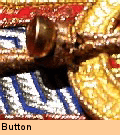
Yaks provide three kinds of hair. All are used by nomads in their daily life, for various purposes. The coarsest is belly hair, and is most commonly used to make tent fabric and cushions for yak-saddles. The medium-grade is from the sides and back of the yak, and is used to make saddlebags, storage covers, and blankets. The softest grade is from the neck of the yak. It is very soft and has been likened to cashmere. This is the hair sold most commonly on the mass market, but almost always mixed with other fibers like bamboo, silk, or alpaca.

All three types are used in weavings. The processing is different for the different types. The finest, softest variety requires a fine spin and also hard-working in hot water, and the guard hairs are usually spun in a simple backstrap tabby weave, while the fine hair is woven on a sit-down machine, in a diagonal tweed weave.
Yak guard hair is almost always black, except for that from a few white yaks (these tend to exist in concentrated areas) and from the small white areas on black yaks. Yak down fiber is always a deep chocolate brown. It can be bleached and dyed into lighter colors, but this of course decreases the quality of the fiber.
There is an area in the south-western part of Kham that uses a fourth kind of yak-hair –- the shed baby hair of year-old yaks. This hair is fuzzy and covers the body of a baby yak. When spun and woven, it is finer and softer than medium-grade adult back hair, though not as soft as the neck hair.

Sheep provide wool, which is used for weaving and felting. The felt is made with a working and kneading process, which binds the hairs together. Tibetan felt is very strong. It is also highly waterproof. Unlike factory felt, which is formed simply by pressing the wool together into a thin cake, Tibetan felt can be washed and will not fall apart.
Wool is spun and woven into cloth, just as yak-hair is. It is a medium grade between the softest and medium yak-hair. Nomads in some lower altitude areas keep sheep, and those from other areas travel to buy their wool. Tibetan sheep wool is almost always white, and often the colorful dyed bits you see in our cloth are wool rather than yak.
Both yak down and wool tweed can be washed and worked to add thickness and softness. However, because our yak down is hand-processed, it is not as soft as machine processed down, which has had all of the coarse guard hairs removed. With hand processing, there is always some scratchiness from the bits of guard hair left.

Yaks also produce thick leather. This leather is traditionally cleaned and then cured with calf-brain and softened with yak butter. You will find that this kind of leather arrives with an odor of the grasslands: yak-butter. Eventually, like with any leather,this smell wears off, to the chagrin of some and the satisfaction of others. Some of our leather has a more familiar odor; it is worked and dyed red and black by the common modern process, in small workshops near highland towns. Periodically, also, you will find bits of other hides, as with our goat-hide food bags.
Yak horns are used sometimes for buttons.

Stiff reeds are used for strengthening bowl and bell covers.


Finally, there are bits and pieces of other things, bought in town — metal buttons, bits of brocade, stretches of brightly colored cotton string.
